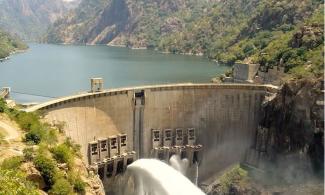
There would be a gradual release in days ahead due to heavy rainfall in Cameroon.
Adamawa, Taraba and some other Nigerian states have been identified as the first point of contact when the volume of water from downstream River Benue increases.
Authorities in Cameroon have alerted the Nigerian government that they would open Lagdo Dam to release water, which will put some Nigerian states at risk of being flooded.
On Monday, the Yola Operations Office Coordinator of the Nigeria Hydrological Services Agency (NIHSA), Ladan Ayuba gave SaharaReporters a list of the states likely to be affected as Benue, Nasarawa, Kogi, Edo, Enugu, Anambra, Delta, Rivers and Bayelsa.
He explained that there would be a gradual release in days ahead due to heavy rainfall in Cameroon.
He, however, added that the water had yet to be released.
"When the water will be released depends on the agreement between the Nigerian Government and Cameroon. They have to agree on the modalities so that it will not cause havoc," he added.
SaharaReporters had reported that observations from the NIHSA showed an increase in the volume of water flow along the River Benue downstream.
It was noted that the flow level at NIHSA's gauging station in Makurdi, Benue State was at 8.97 meters as of August 25, 2023, compared to 8.80 meters on the same date in 2022.
SaharaReporters reported on Sunday that the Ministry of Foreign Affairs for East and Central African Division had alerted the National Emergency Management Agency (NEMA) to an impending flooding along the River Benue basin.
It noted that it had received a notice from the High Commission of the Republic of Cameroon informing that the country's officials would open the floodgates of the Lagdo Dam on the Benue River in the days ahead.
The letter titled 'Cameroonian Officials To Open The Flood Gates Of The Lagdo Dam On The Benue River In Cameroon,' from the Nigerian foreign affairs ministry and addressed to the Director General of the NEMA was dated August 21, 2023, and received by NEMA on August 25, 2023.
It said the dam would be opened due to the heavy rainfall around the Dam catchment area in Northern Cameroon.
In a statement on Sunday, NEMA listed the Nigerian states downstream of River Benue that could be affected by the release of water from Lagdo Dam in Cameroon.
However, NEMA on Sunday allayed the fears of Nigerians over the planned release of the excess water from Lagdo Dam, which is located on River Benue in the Republic of Cameroon.
In a statement issued by the Head of the Press Unit at NEMA in Abuja, Manzo Ezekiel, the agency said it was "working with critical stakeholders at the Federal, States and Local Governments to ensure that the release will not cause much negative impacts on the low-lying communities along the states that would be affected".
It listed the states downstream of River Benue as "Adamawa, Taraba, Benue, Nasarawa, Kogi, Anambra, Enugu, Edo, Delta, Rivers and Bayelsa States".
However, on Monday, SaharaReporters learnt that in contrast to the water flow downstream of the River Benue, the flow level of the River Niger system, specifically at Niamey, Niger Republic, remained stable at a normal level of 4.30 meters. Similarly, inland dams including Kainji, Jebba, and Shiroro reported consistent flow regimes.
“With regards to the hydrological station downstream, the confluence of the Niger and Benue rivers in Lokoja, Kogi State, is currently within normal limits. The downstream monitoring station, however, registered a flow level of 7.80 meters on August 25th, 2023, compared to 8.24 meters on the same date in 2022.
“Recognizing Nigeria's downstream position within the Niger River Basin, NIHSA maintains an active information-sharing relationship with Cameroon's National Hydrological Services on water releases,” a statement from NIHSA said.
It, however, stressed that the water had yet to be released.
“It is a notification for intention to release,” it said.